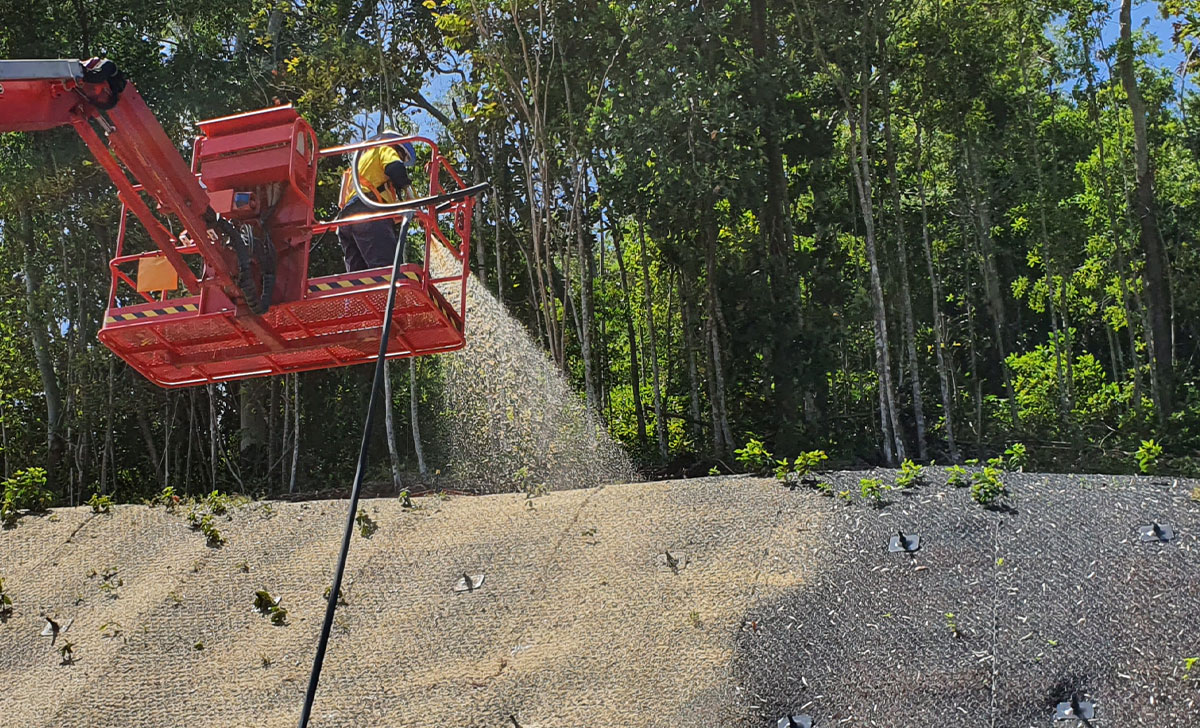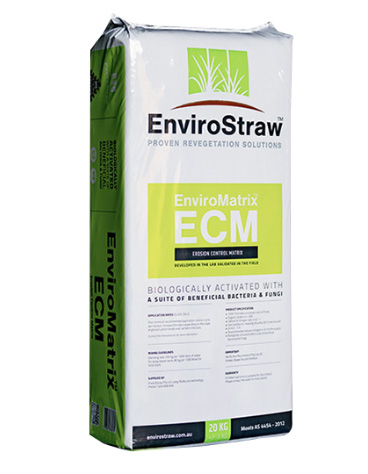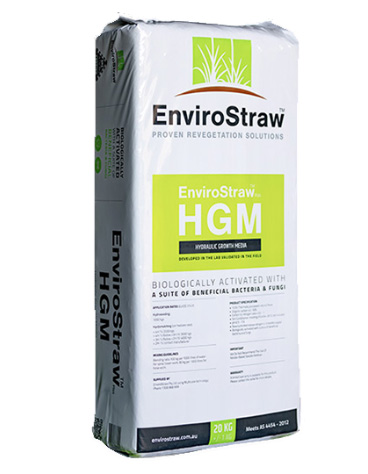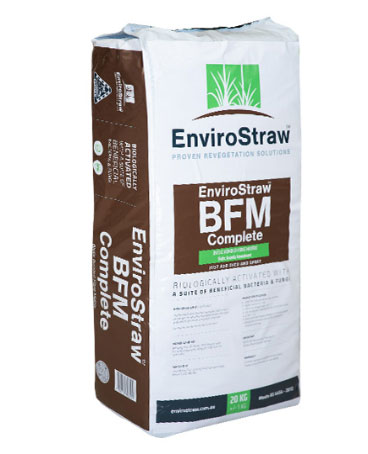A revolutionary innovation that offers superior coverage, seed protection, moisture retention and erosion control, straw-based hydromulch has completely transformed the hydraulic revegetation industry and proven to be extremely effective on countless commercial infrastructure development projects and mine sites.
Not all forms of hydromulch are made equal, and the consensus from revegetation experts is that mechanically and thermally processed straw-based hydromulch has taken over as the leader in hydromulch media.
There are several key criteria to a superior hydromulch product:
- It is thermally and mechanically processed.
- It is manufactured from a renewable resource.
- It becomes a thick viscous slurry when mixed for ease of use and application.
- It provides exceptional ground coverage, minimising erosion and increasing seed protection and germination.
- It encourages water permeation into the soil below so that deep-rooted plants can establish, providing long-term self-sustaining outcomes.
- It is independently lab tested to prove its efficacy.
- It has a balanced carbon-to-nitrogen ratio of below 50-1 to minimise nitrogen drawdown and other nutrient lock-up issues.
- It has a high mix ratio of water-to-hydromulch fibre, lowering the volume of water required. This saves water and reduces CO2 emissions released into the environment during the application process.
- It is environmentally responsible, ensuring there is no contamination from viable weed seeds or other pathogens into the environment or our precious waterways.
While several alternative hydromulch fibres are available on the market today, none can deliver the superior germination and sustainability benefits of our straw-based solution.
Other types of hydromulch and their disadvantages:
Cellulose-based hydromulch, typically manufactured from recycled newspaper. The low water-to-mulch mix ratio is a key challenge associated with cellulose-based hydromulch, increasing the volume of water required during the application process. Increased vehicle movements around the site also lead to increased production of CO2 emissions. Over-application of this fibre for the sake of erosion minimisation can adversely affect seed germination and plant establishment, a phenomenon known as ‘the paper mache effect’. It usually has a high carbon-to-nitrogen ratio, which causes nitrogen drawdown issues in establishing plants.
Sugar cane cellulose blended hydromulch. This fibre is typically non-thermally processed, creating environmental risks in regard to weed seed and pathogen contamination from the harvested paddock to the application site. It has a low water-to-mulch mix ratio, requiring high volumes of water during application. This increases the required number of trips around the treatment site, leading to more CO2 emissions. With a high carbon-to-nitrogen ratio, nitrogen drawdown is also a common challenge.
Mechanically and thermally processed wood fibre-based hydromulch. Although it is often touted as a renewable resource, the wood used in hydromulch is sourced from trees which take up to 20 years to grow, and the processing of the fibre uses a significant amount of energy. It typically has a carbon-to-nitrogen ratio of above 100 to 1, leading to nitrogen drawdown, and a low water-to-mulch mix ratio, meaning large volumes of water are required during application. This means more vehicle movements around the site, in turn increasing the CO2 emissions produced during the application process.
How straw hydromulch benefits the environment
As a new and improved innovation in the field, straw-based hydromulch offers many benefits for contractors and site owners. Each bale of EnviroStraw hydromulch is designed with the traits to produce the best possible outcomes on a wide range of revegetation projects. Key considerations include:
| High water permeation Not only can straw-based hydromulch hold up to six times its weight in water, enhancing seed strike, but it also increases permeation of water into the soil below. This maximises the positive impact of application, encouraging deep-root plant establishment and long-term self-sustaining outcomes. |
| Erosion protection Thermally and mechanically processed straw-based hydromulch conforms closely to the soil surface, offering immediate protection against surface rilling and erosion caused by raindrop impact and overland flow. |
| Effective vegetation growth Straw hydromulch has been proven to produce effective revegetation outcomes, establishing strong, drought-resistant plants in some of the harshest conditions in the world. |
| Soil balance With its nutrient-dense fibre, straw-based hydromulch provides a food source for microbes. These microbes in turn feed the plants, building topsoil and overall soil health and facilitating deep-rooted plant establishment – all of which ultimately leads to long-term, self-sustaining outcomes. |
| Sustainability Environmental responsibility is a key consideration in the creation of effective revegetation solutions, and mechanically and thermally processed straw hydromulch is no exception. With its unique water-holding characteristics, straw hydromulch reduces the amount of water required during the application process and the CO2 emissions produced by truck movements on site.Fast-growing and abundantly available, straw fibre is a truly sustainable fibre because it is a by-product of the wheat industry. |
How straw hydromulch benefits contractors and land owners
In addition to environmental outcomes, quality revegetation solutions are also defined by the ease of use and cost-effectiveness of the product, particularly in comparison to other more expensive hydromulch products. Key considerations for contractors and site owners include:
| Cost Straw is not only one of the least expensive mulch cover options available, it is also the most cost-effective during application and ongoing maintenance. The fact that it requires less water than standard hydromulch products substantially reduces the overall cost of the resource itself and the cost of running water trucks on site. |
| Soil coverage The pressure and heat used during the production of straw-based hydromulch breaks it down into a more flexible and water absorbent material, which improves ground coverage. With an extended functional longevity of up to 18 months on site, straw-based hydromulches are typically more effective in establishing long-term self-sustaining vegetation solutions.Our all-in-one-bag products EnviroStraw BFM Complete and EnviroMatrix Erosion Control Matrix (ECM) are designed to improve on-site compliance and deliver truly environmentally responsible outcomes. Simply add seed and spray. |
| Productivity Straw hydromulch can be applied in one quick, easy step, increasing on-site productivity for contractors and site owners. All EnviroStraw hydromulch products are designed with this in mind, particularly our all-in-one-bag solutions EnviroMatrix ECM and EnviroStraw BFM Complete. |
How EnviroStraw’s hydromulch products use straw fibre
The incorporation of natural, truly renewable straw fibre is an innovative addition to the hydraulic revegetation industry.
With straw-based hydromulch products, contractors and site owners can expect to reap more benefits from what they sow. Are you a contractor or site owner looking to improve your outcomes on site? Give our team of specialists a call on 1300 868 669.



